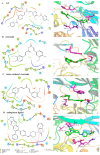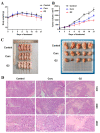Discovery of Novel Mono-Carbonyl Curcumin Derivatives as Potential Anti-Hepatoma Agents
- PMID: 37836639
- PMCID: PMC10574324
- DOI: 10.3390/molecules28196796
Discovery of Novel Mono-Carbonyl Curcumin Derivatives as Potential Anti-Hepatoma Agents
Abstract
Curcumin possesses a wide spectrum of liver cancer inhibition effects, yet it has chemical instability and poor metabolic properties as a drug candidate. To alleviate these problems, a series of new mono-carbonyl curcumin derivatives G1-G7 were designed, synthesized, and evaluated by in vitro and in vivo studies. Compound G2 was found to be the most potent derivative (IC50 = 15.39 μM) compared to curcumin (IC50 = 40.56 μM) by anti-proliferation assay. Subsequently, molecular docking, wound healing, transwell, JC-1 staining, and Western blotting experiments were performed, and it was found that compound G2 could suppress cell migration and induce cell apoptosis by inhibiting the phosphorylation of AKT and affecting the expression of apoptosis-related proteins. Moreover, the HepG2 cell xenograft model and H&E staining results confirmed that compound G2 was more effective than curcumin in inhibiting tumor growth. Hence, G2 is a promising leading compound with the potential to be developed as a chemotherapy agent for hepatocellular carcinoma.
Keywords: AKT inhibition; anti-hepatoma activity; curcumin derivatives; molecular docking; xenograft model.
Conflict of interest statement
The authors declare that they have no known competing financial interests or personal relationships that could have appeared to influence the work reported in this paper.
Figures








Similar articles
-
Synthesis and antitumor evaluation of amino acid conjugates of monocarbonyl curcumin in hepatocellular carcinoma cell.Sci Rep. 2025 Mar 10;15(1):8181. doi: 10.1038/s41598-025-93451-1. Sci Rep. 2025. PMID: 40065100 Free PMC article.
-
Design, Synthesis, and Antitumor Evaluation of Novel Mono-Carbonyl Curcumin Analogs in Hepatocellular Carcinoma Cell.Pharmaceuticals (Basel). 2022 Jul 30;15(8):950. doi: 10.3390/ph15080950. Pharmaceuticals (Basel). 2022. PMID: 36015097 Free PMC article.
-
Curcumin-loaded galactosylated BSA nanoparticles as targeted drug delivery carriers inhibit hepatocellular carcinoma cell proliferation and migration.Int J Nanomedicine. 2018 Dec 6;13:8309-8323. doi: 10.2147/IJN.S184379. eCollection 2018. Int J Nanomedicine. 2018. PMID: 30584302 Free PMC article.
-
The role of the vascular endothelial growth factor/vascular endothelial growth factor receptors axis mediated angiogenesis in curcumin-loaded nanostructured lipid carriers induced human HepG2 cells apoptosis.J Cancer Res Ther. 2015 Jul-Sep;11(3):597-605. doi: 10.4103/0973-1482.159086. J Cancer Res Ther. 2015. PMID: 26458588
-
Design, molecular docking, in vitro, and in vivo studies of new quinazolin-4(3H)-ones as VEGFR-2 inhibitors with potential activity against hepatocellular carcinoma.Bioorg Chem. 2021 Feb;107:104532. doi: 10.1016/j.bioorg.2020.104532. Epub 2020 Dec 8. Bioorg Chem. 2021. PMID: 33334586
Cited by
-
Synthesis and antitumor evaluation of amino acid conjugates of monocarbonyl curcumin in hepatocellular carcinoma cell.Sci Rep. 2025 Mar 10;15(1):8181. doi: 10.1038/s41598-025-93451-1. Sci Rep. 2025. PMID: 40065100 Free PMC article.
-
Mechanism of Radix Bupleuri and Hedysarum Multijugum Maxim drug pairs on liver fibrosis based on network pharmacology, bioinformatics and molecular dynamics simulation.PLoS One. 2025 Jan 27;20(1):e0318336. doi: 10.1371/journal.pone.0318336. eCollection 2025. PLoS One. 2025. PMID: 39869574 Free PMC article.
-
Anticancer Drug Discovery Based on Natural Products: From Computational Approaches to Clinical Studies.Biomedicines. 2024 Jan 16;12(1):201. doi: 10.3390/biomedicines12010201. Biomedicines. 2024. PMID: 38255306 Free PMC article. Review.
-
Mechanism of Dahuang-Dangshen drug pairs in the treatment of HCC based on network pharmacology, bioinformatics, molecular docking and experimental verification.Med Oncol. 2025 Apr 22;42(5):174. doi: 10.1007/s12032-025-02738-w. Med Oncol. 2025. PMID: 40261593
References
-
- Noorafshan A., Ashkani-Esfahani S. A review of therapeutic effects of curcumin. Curr. Pharm. Des. 2013;19:2032–2046. - PubMed
-
- Ireson C.R., Jones D.J.L., Orr S., Coughtrie M.W.H., Boocock D.J., Williams M.L., Farmer P.B., Steward W.P., Gescher A.J. Metabolism of the cancer chemopreventive agent curcumin in human and rat intestine. Cancer Epidemiol. Biomark. Prev. 2002;11:105–111. - PubMed
MeSH terms
Substances
Grants and funding
LinkOut - more resources
Full Text Sources
Medical

